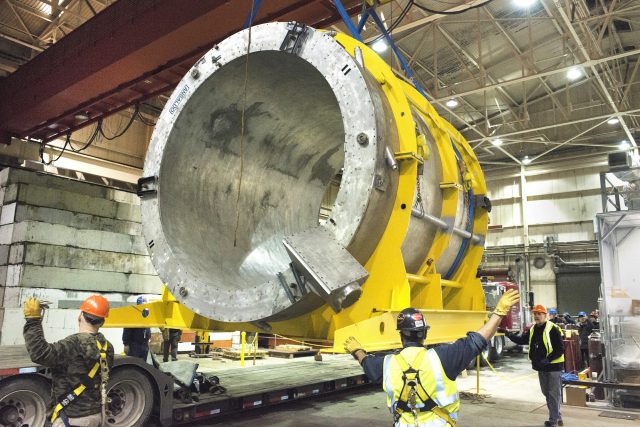
Aurich Lawson / Getty Images
the starting story plus a
landing page for the entire series on site.
The future is already here—it’s just not very evenly distributed –William Gibson
As tool builders, it is only very recently that we’ve been able to use quantum mechanics. Understanding and manipulating quantum devices has been like getting an intoxicating new superpower—there are so many things we can now build that would have been impossible just a few years ago.
We encountered a few of these quantum technologies in the previous articles. Some of them, like the quantum dots in TVs, are already becoming commonplace; others, like optical clocks, exist but are still very rare.
As this is the last article in this series, I’d like to look to a near future where quantum technologies are likely to infuse our everyday existence. One does not have to look far—all of the technologies we’ll explore today already exist. Most of them are still rare, isolated in laboratories or as technology demonstrators. Others are hiding in plain sight, such as the MRI machine at the local hospital or the hard drive sitting on your desk. In this article, let’s focus on some of the technologies that we did not encounter in earlier articles: superconductivity, particle polarization, and quantum electronics.
As we look at these quantum technologies, envision what it will be like to live in a world where quantum devices are everywhere. What will it mean to be technically literate when knowing quantum mechanics is a prerequisite for understanding everyday technology?
So pick up your binoculars, and let’s look at the quantum technologies coming over the next ridge.
MRI magnets under construction at the Philips Healthcare production facility in 2010.
Jock Fistick/Bloomberg via Getty ImagesA magnet levitating above a superconductor—this makes a great classroom demonstration!
Superconductors
In a normal conducting wire, you can attach a battery and measure how quickly the electrons move through it (the current, or number and speed of electrons). It takes some pressure (voltage) to push the electrons through, and doing that pushing releases some heat—think of the red glow of the coils in a room heater or hair dryer. The difficulty of pushing the electrons through a material is the resistance.
But we know that electrons move as waves. As you cool down all the atoms in a material, the size of the electron waves carrying the electric current become larger. Once the temperature gets low enough, this waviness can go from being an annoying subtlety to the defining characteristic of the electrons. Suddenly the electron waves pair up and move effortlessly through the material—the resistance drops to zero.
The temperature at which the waviness of electrons takes over depends on the crystal the electrons are in, but it is always cold, involving temperatures at which gasses like nitrogen or helium become liquids. Despite the challenge of keeping things this cold, superconductivity is such an amazing and useful property that we’re using it anyway.
Electromagnets. The most widespread use of superconductivity is for the electromagnets in MRI (Magnetic Resonance Imaging) machines. As a kid, you may have made an electro-magnet by coiling a wire around a nail and attaching the wire to a battery. The magnet in an MRI machine is similar, in that it’s just a big coil of wire. But when you have ~1000 Amps of current flowing through the wire, keeping the magnet working becomes expensive. It would normally end up looking like the world’s largest space heater.
So the answer is to use a special wire and cool it down in liquid helium. Once it is superconducting, you can plug it into a power source and ramp up the current (this takes 2-3 days—there’s a great video of plugging in an MRI magnet). Then you unplug the magnet and walk away. Because there is no resistance, the current will continue to flow for as long as you keep the magnet cold. When a hospital installs a new MRI, the magnet is turned on when it is installed, then unplugged and left on for the rest of its life.

While MRI machines are the most visible examples, superconducting magnets are actually quite common. Any good chemistry laboratory or department will have several superconducting magnets in their Nuclear Magnetic Resonance (NMR) machines and mass spectrometers. Superconducting magnets line 18 km of the Large Hadron Collider and they show up in other ways in physics departments. When we had a shoestring project, we scrounged up a superconducting magnet from the storage alley behind my lab and refurbished it. Physicists are mailed glossy catalogs by superconducting magnet manufacturers.
Transmission lines. The next obvious application is to stretch a superconducting wire out and use it to carry electricity. There are several demonstration projects around the world that use superconducting power lines. As with most industrial applications, it is just a matter of finding cases where the performance of a superconductor is worth its high price. As the price comes down, long distance superconducting transmission lines may become crucial as we add more renewable solar and wind energy to the grid—being able to losslessly ship power long distances can even out the local variations in renewable power production.
Generators and motors. If you have incredibly strong superconducting magnets, you want to use them in electric generators and motors. Cooling, as always, is an issue, but the much stronger magnets can make the motor/generators significantly smaller and more efficient. This is particularly enticing for wind turbines (reduced weight on the tower), and electric drives for boats and aircraft (reduced weight and improved efficiency).



